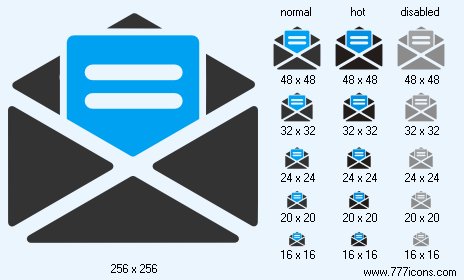


|
| ||||||||
|
|
Open Mail Icon |
|
Image sizes: 256x256, 128x128, 64x64, 48x48, 32x32, 24x24, 20x20, 16x16, 512x512
File formats: BMP, GIF, PNG, ICO
Picking An Appropriate Image Format When Making Graphics.
There are numerous file formats that should be utilized for saving images and for a relatively raw designer this can often lead to a major problem because you should know how to use a particular file format, here is a a take on the advantages and issues of some commonly used image formats.If you are keen on icon making or wish to create graphical representations for your site, it is imperative to know about the different image file formats and their features so that you can make use of the right file format for an image. Normally used file formats for images are PNG, GIF and JPEG, each one of these file formats has its own traits so lets discuss the advantages and disadvantages of using these file formats, the type of image format that will meet the expectations your website and optimizing your icons for the internet.
GIF: It is short for Graphics Interchange Format; this is one of the more well known file types. The image format is well accepted because of its tiny image size which makes uploading less time consuming. Unlike JPEG, information is not lost in this format this means you will be able to store the image without using up a lot of space and deteriorating the quality of the picture. GIF offers transparency support in images, it is the most suitable image formats for picture creation. Unlike the other image formats, animation is also offered in GIF. If you would like to go for GIF file optimization, it is important to restrict the size of the file; it would be best that you pick a 32 color palette to achieve a suitably small size.
JPEG: This is short for Joint Photographic Experts Group; the image format is usually called JPG and is usually seen on websites. One of the main benefits of using this type of format is that you can save the images in true color that offers you an impressive range of 16 million colors; this renders the file type ideal for use with photos and pictures that boast of vast color work. One of the issues of utilizing JPG is the data loss that you will have to deal with every time the image is stored; this equates to the fact that the image is susceptible to compromised clarity and many data may be lost. Unlike the GIF format, transparency is not possible in this file format. If you are using a superior image editor like the Adobe Photoshop, you will be able to choose the quality and the image file size ; however, it is important to realize that a lower resolution equates to a smaller size, which is simple to upload.
PNG: Is stands for Portable Network Graphics and is a fairly fresh file type. This format is available in two forms; PNG-8 which has a 8 bit color format and the PNG-24 which offers 24 color pictures. PNG-8 can curtail the size graphics with wonderful detail and without the customary loss of data observed in GIF files; this results in high image quality and quick uploads. However, PNG-24 is not as efficient as JPG when you have to store photos and other illustrations that merit the use of a wider color palette. The format is not limited by loss; this means that the image retains its clarity and quality. PNG-24 offers transparency support and you can include varying degrees of the transparency feature in this format. When you use this file format the images are better looking because they do not have the jagged edges when placed against a background with contrasting colors like GIF files.
Copyright © 2006-2022 Aha-Soft. All rights reserved.
|

